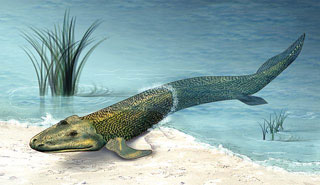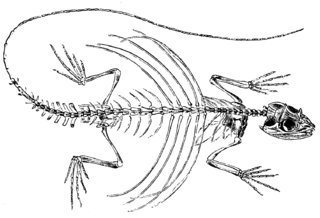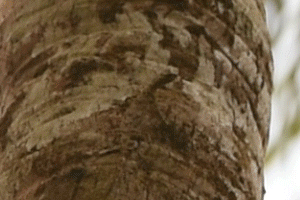Lets talk about dragons. Seriously.
Note: This post was originally published in my Facebook account in 2016. Here you may see its enhanced version translated into english, with some additional information, compiled from the comments of the original post.
The Crucial Problem of Dragons
From fantasy literature we know nearly everything about dragons. Here are their main features:
- four legs and two wings
- they can fly
- they can spew fire

Forget about the fire for the moment. And you see an interesting creature, which has no analogs in the real world… almost.
The problem is that all amphibians, lizards, birds and beasts have only four limbs. The reason is in fish. More precisely - in fish fins.
Fish has many fins, but there are only two paired fins: pectoral fins (1), pelvic fins (2), which are located symmetrically on the left and right sides of a fish:

Approximately 400 million years ago the lungfish decided to learn how to walk off the water. So its fins evolved into something we call limbs now. And it had only four of them.

That is why all amphibians, lizards, birds and beasts have only four limbs. They all are descendants of those lungfish.
Birds and bats, for example, had to turn their front limbs into wings to fly. At the same time, they in fact have lost the ability to walk quickly on the ground or grab something with those former front paws which are wings now.
This is why the real birds and bats are not as good as the imaginary dragons!
The New Hope
But there is a hope! There is a lizard called Draco (also known as “Flying Dragon”). Unfortunately, it can’t fly, but is capable of gliding.

They have a special patagial membranes supported by elongated thoracic ribs.

In order to start gliding this lizard jumps off the tree and straightens its membrane. Recent study shows that the membrane muscles are too weak, that is why it has to use its forelimbs to grab the front of the patagium membrane to control the glide.

This lizard could be transformed into a flying dragon with the means of directed evolution. We need to convert its gliding membrane into fully functional wings.
Directed Evolution
What is this directed evolution? It is when we create some special living conditions for these lizards, and at the same time conduct selected breeding. I believe that in merely 500…1000 years we can create a new specie of a real flying dragon.
What are those special living conditions? I would suggest the following.
Don’t use forelimbs to fly
In order to strengthen membrane muscles, we need to make them NOT use their forelimbs to straighten the membrane and control the flight.
We can occupy their forelimbs with some other task. For example: catching food.
These lizards eat insects. That is why we can leave them only with butterflies, dragonflies, etc. so lizards would have to catch them during the flight.
No walking on ground
We need to ensure that lizards live on trees and practice their flight, so we should keep them off the walking on earth.
This could be easily achieved if we introduce some natural predator, waiting them on the ground.
Selected breeding
In each generation we should select those lizards, which have the largest membranes with the strongest muscles. These selected lizards should give birth for the next generation.
Of course, the lizard’s population should be large enough to avoid inbreeding problem.
Make them flight longer
Over the course of experiment, we need to slowly increase the distance between the trees, so that the lizards would have to learn how to fly longer.
Funding
Costs Estimation
How can one estimate the size of investments required for such an experiment?
I believe this experiment costs almost as much as the maintenance of a nature park. Such nature parks are almost in each country. For example: in South Africa there are 13 parks.
Let’s look inside the yearly report about nature parks of South Africa for 2015. At page 83 we see “Expenditure” = 2’507’495’000R. What is (at the exchange ratio 0.072 USD/R) about: 180’539’640 USD. Or 13’887’664 USD for one nature park per year.
Obviously, it is very hard to find 14M USD annually for the selection of dragons! In fact, the experiment will take several hundreds of years, and no investor would ever make a profit out of it. It seems absolutely unreal.
Though, there is one interesting solution…
Solution for the Funding
We can create a religion, a church, whose main goal would be the creation of real flying dragons. We can call it: “Church of Flying Dragons Spewing Fire”, or “Dragons Holy Selection Church”.
Dragon’s Church has benefits:
- Church followers donate themselves.
- Church followers seek and attract new followers.
- Churches can exist for 1000…2000 years!
This is how you create the dragons. The idea is ready!
Contradictions
Why bother with limbs?
Who said that dragons MUST have four legs and two wings? Take Wyvern, for example. It has only two legs and two wings. Besides, eastern dragons may not have wings at all!
I totally agree, that there are different variants of mythical dragons. But my arguments are:
- In most of sources they have four legs and two wings.
- Wyverns have no advantages over dragons. They are like birds or bats. They can’t grasp anything while walking.
- Why the hell you may ever want the eastern variant of non-flying dragon? It is merely a big lizard!
Why not use genetic manipulation instead of selection?
Would not it be cheaper and faster to use genetic manipulation to add wings to this lizard?
This is a good question!
The fact is, nobody knows what genes should be added into this lizard to create wings. Because there are no creatures with four legs and a pair of wings. We can’t take these genes out of nowhere!
For example: we could search for some genes in birds, and introduce them into the lizard. But most probably it will create wings out of forelimbs, as birds do. This is not what we want!
Humans know too little about the genes for now. That is why directed evolution is the only solution to the problem.
These lizards are too small
These lizards are too small in comparison to dragons!
Yep. And this is very good for our goal. The logic is as follows:
- Typically, the smaller the body - the shorter the life span of a specie. ↓
- The shorter the life span - the faster new generations appear. ↓
- The faster new generations appear - the faster the evolution is.
Besides, big dragons will require much more space and much more food. Thus elevating the costs, required for this project.
Also, I would love to keep a small pet dragon. But I doubt I could keep a huge gluttonous dragon!
